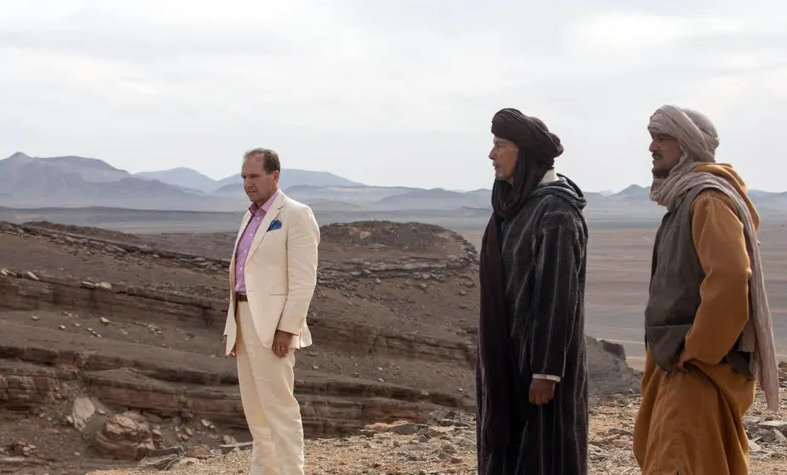
Can we watch any film set in the Saharan desert without instantly thinking of David Lean’s Lawrence of Arabia (1952)? In my forthcoming book Exotic Cinema I do not devote much space to films set in the desert, despite the fact that they feature prominently in contemporary global art cinema, including films such as Theeb (Naji Abu Nowar, 2014), Timbuktu Abderrahmane Sissako, 2014), Queen of the Desert (Werner Herzog, 2015), The Sheltering Sky (Bernardo Bertolucci, 1990) and The Forgiven (John Michael McDonagh, 2022). The spectacular qualities of these sublime North African desert landscapes invite us to marvel at the immensity of the undulating sand dunes in shades of yellow, gold and red, the infinite skies and firmament of stars, the scorching heat, the dazzling bright light and the harsh barrenness of the landscape.
Clearly, the Sahara does not neatly map on to the notion of exotic landscapes, imagined in terms of their sensuous abundance and verdant opulence. Rather the Saharan desert in these films instils a sense of awe (an affect linked with the sublime), rather than with pleasure (the affective response elicited in the encounter with the exotic) in the beholder. Even so, these films inevitably invoke the iconography (and sometimes also the themes) of films that are incontrovertibly exotic (or rather, Orientalist, a distinction I make in the book), such as The Sheik (George Melford, 1921) and Lawrence of Arabia. If, as I propose, exoticism functions like a hermeneutic circuit that relies on the appropriation and reworking of established iconographic conventions and narrative tropes to be recognised as such, then the desert films listed above would qualify as exotic.
Above all, the vastness and emptiness of the desert functions as a projection space for white western fantasies and desires (especially of an erotic nature) as well as deep-seated cultural anxieties and fears (e.g. of the threat of jihadism). In several films, the Sahara is depicted as a site of peril and moral liminality that puts cultural outsiders who venture forth to the test. Insofar as the encounter with the exoticised Other is a profoundly transformative experience, the desert emerges as a quintessentially exotic locality in which the identities of white western travellers and tourists unravel in the close encounter with profoundly different cultures.
Bernardo Bertolucci’s The Sheltering Sky and The Forgiven revolve around couples whose marriages are faltering against the backdrop of the North African desert. In Bertolucci’s film, based on a novel by Paul Bowles, Port (John Malkovich) and his wife Kit (Debra Winger) have travelled from the US to French Algeria in 1947, in the hope that their fraying marriage may be saved by a change of scene. David (Ralph Fiennes) a British doctor and his American wife Jo (Jessica Chastain) have flown in from England for the weekend for a decadent party in lavish palace in the middle of the desert with their super rich friends. En route in the dark desert, David, who refers to himself as ‘a highly functioning alcoholic’, hits and kills a local Berber boy, Driss (Omar Ghazaoui). Later, the dead boy’s father, Abdellah (Ismael Kanater) and some other Berber men show up at the palace, demanding that David accompany them to the remote village and participate in the burial rites, as custom demands. Bigoted and racist, he at first suspects Abdellah and his people to be members of Isis, but spending time with Abdellah, he begins to respect the values and world view of the remote Berber tribe and submits to the funeral rituals to pay his respect. Whereas The Sheltering Sky, made some thirty-two years earlier, rarely prompts us to question western cultural prejudice and privilege, The Forgiven pits white western privilege and debauchery against the moral integrity of the local Berber community and leaves us in no doubt about their moral superiority. Defying ethnic stereotypes, the Moroccan men, despite being dressed in traditional Berber attire and living in poverty (certainly when compared with the ostentatious wealth of the partying westerners), are eloquent communicators, speaking the Berber language Tamazight amongst themselves, Arabic with Moroccans at the gated palace and English with David.
The Sheltering Sky appropriates familiar colonial exotic cliches of the desert and its people. When Port succumbs to typhoid fever and dies, Kit is rescued by a passing Arab and his caravan. In the guise of a young man, she becomes part of Belqassim’s (Eric Vu-An) harem and experiences intoxicating sensuous fulfilment (a departure of the film from Bowles’ book). Like in earlier films set in the North African desert, it is imagined as a site of liberation, where the moral precepts of the west are suspended. Bewildered by the exotic-erotic encounter with Belqassim and utterly overwhelmed by the radical alterity of the desert, Kit loses her hold on reality.
The desert in these two films is much more than merely an exotic spectacle. As a site of cross-cultural encounters it destabilises the identities of cultural outsiders, pushing them to the brink of madness, even annihilating them. Port succumbs to typhus and dies in a miserable bare room in the barracks of the French Legion. David, who passes the site where the fatal accident occurred upon his return journey, faces justice in the end and is shot dead by one of Driss’s friends.